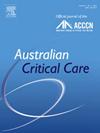在重症监护室实施可重复使用床单:对压力伤害、员工满意度和环境可持续性的影响
IF 2.7
3区 医学
Q2 CRITICAL CARE MEDICINE
引用次数: 0
摘要
压力性损伤(pi)仍然是重症监护病房(icu)的一个主要问题,导致发病率增加、医疗费用增加和住院时间延长。虽然存在各种预防策略,但可重复使用亚麻对PI发生率和环境可持续性的影响仍未得到充分探讨。目的通过对环境影响和医护人员接受程度的评估,评价由一次性布草向可重复使用布草过渡对ICU患者PI发病率的影响。方法在单一大城市ICU进行前后对比研究,比较可重复使用亚麻制品实施前(2022年4月- 2023年3月)和实施后(204月- 2024年3月)患者的预后。分析来自电子病历和内部风险监测系统(RiskMan®)的数据,以确定与PI发展相关的因素。进行护理人员满意度调查,量化垃圾填埋减量。结果在2114例患者中,与使用一次性布草相比,使用可重复使用布草后的pi发生率显著降低(p =<;0.05)。尽管布草类型与PI发生之间存在弱显著相关(χ2 (1) = 4.23, p = 0.040, 95%可信区间[CI]: 0.001-0.042),且效应值较小(cram本文章由计算机程序翻译,如有差异,请以英文原文为准。
Implementation of reusable linen in the intensive care unit: Impact on pressure injury, staff satisfaction, and environmental sustainability
Background
Pressure injuries (PIs) remain a major concern in intensive care units (ICUs), leading to increased morbidity, healthcare costs, and extended hospital stays. While various prevention strategies exist, the impact of reusable linen on PI incidence and environmental sustainability remains underexplored.
Objectives
The effect of transitioning from disposable to reusable linen on PI incidence among ICU patients was evaluated while assessing environmental impact and staff acceptance.
Methods
A before–after study was conducted in a single major metropolitan ICU comparing patient outcomes before (April 2022–March 2023) and after (April 2023–March 2024) reusable linen implementation. Data from electronic medical records and an internal risk monitoring system (RiskMan®) were analysed to identify factors associated with PI development. A nursing staff satisfaction survey was conducted, and landfill waste reduction was quantified.
Results
In 2114 patients, the incidence of PIs was significantly reduced after reusable linen was implemented compared to that observed while using the disposable linen (p =< 0.05). Although a weak significant association was found between linen type and PI occurrence (χ2 (1) = 4.23, p = 0.040, 95% confidence interval [CI]: 0.001–0.042), with a small effect size (Cramér's V = 0.0447), once adjusting for other factors, linen type was no longer a significant predictor. Acute Physiology and Chronic Health Evaluation III score (odds ratio [OR] = 1.011, 95% CI: 1.003–1.019), age (OR = 0.976, 95% CI: 0.963–0.989), sex (OR = 0.53, 95% CI: 0.340–0.823), diabetes status (OR = 1.29, 95% CI: 1.109–1.499), and ICU length of stay (OR = 1.23, 95% CI: 1.188–1.276) were significant predictors of PI development. Staff satisfaction with reusable linen was high (n = 22, 87.2%), with benefits including usability and sustainability. The transition to reusable linens eliminated 496 kg of landfill waste annually.
Conclusions
Reusable linen was not inferior to disposable linen for the prevention of PI and offered substantial environmental benefits. Strong staff support and reduced waste indicate reusable linen is a viable alternative in ICU settings. Further research is needed to explore long-term impacts.
求助全文
通过发布文献求助,成功后即可免费获取论文全文。
去求助
来源期刊

Australian Critical Care
NURSING-NURSING
CiteScore
4.90
自引率
9.10%
发文量
148
审稿时长
>12 weeks
期刊介绍:
Australian Critical Care is the official journal of the Australian College of Critical Care Nurses (ACCCN). It is a bi-monthly peer-reviewed journal, providing clinically relevant research, reviews and articles of interest to the critical care community. Australian Critical Care publishes peer-reviewed scholarly papers that report research findings, research-based reviews, discussion papers and commentaries which are of interest to an international readership of critical care practitioners, educators, administrators and researchers. Interprofessional articles are welcomed.
 求助内容:
求助内容: 应助结果提醒方式:
应助结果提醒方式:


